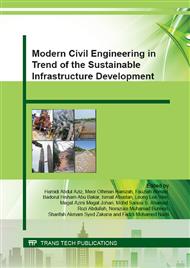p.243
p.249
p.255
p.261
p.267
p.272
p.277
p.283
p.290
Properties of Cement Mortar Consisting Raw Rice Husk
Abstract:
Most of the rice husk is disposed with no further concern and this has caused waste disposal problems. Burning rice husk can cause health and environmental problem. Rice husk ash has been widely used for concrete technology application as additive in concrete mixture. However there is lack of study on the usage of raw rice husk. This paper presents the experimental on the properties of cement mortar consisting raw rice husk which focused on the porosity and density. Specimens were prepared by incorporating different percentage of rice husk with mortar. Summation of 10 mixes has been investigated to determine the compressive strength, density, porosity and water absorption. As the main purpose of the rice husk cement mortar is for drainage material, the main characteristics needed are porosity and lightweight. From the results, it is concluded that the higher percentage of rice husk used, will decreased the compressive strength and density and increased the porosity of rice husk cement mortar.
Info:
Periodical:
Pages:
267-271
Citation:
Online since:
October 2015
Keywords:
Price:
Сopyright:
© 2015 Trans Tech Publications Ltd. All Rights Reserved
Share:
Citation:


